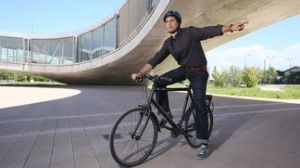Jul 29 2014
Five EPFL PhD students have developed a wristband that flashes when the rider reaches out to indicate a turn. Their invention was recognized at a European competition.
 © 2014 EPFL
© 2014 EPFL
In large cities it can be difficult for cyclists to brave traffic with confidence. This is the case particularly at night, when it comes to changing lanes in the middle of motorists. Based on this reality, five doctoral students of the Electronics Laboratory (ELab) at EPFL have developed a smart illuminating wristband for added safety when riding in traffic. Equipped with LED and other electronics, the bracelet flashes when the cyclist reaches out to indicate a lane change. Called "Intelligent Blinker," the project was recognized at the Texas Instruments Analog Design Contest, a European competition held in Munich.
Running on Solar Energy
The principle of the bracelet is relatively simple. The device consists of an accelerometer and a magnetometer - a kind of compass - that can detect the position of the user's arm. When the rider reaches out laterally, the accelerometer and magnetometer provide data to a microcontroller, which directs the LED to engage. "According to the habits of the rider, it's possible to adjust the angle at which the LED starts flashing," says Pietro Buccella, one of the students participating in the project. The bracelet is also equipped with small solar panels connected to a battery. It is therefore possible to run it only on solar energy. "We still equipped it with a USB port to enable recharging with a computer, if necessary," says the student.
Towards a multi-function wristband
At a size of about five square centimeters, the circuit controlling the operation of the wristband is too bulky to be worn comfortably. It must be said that the young scientists developed their invention in just three months, on their own time, under the supervision of the Director of ELab, Maher Kayal.
In the near future, the wristband will be miniaturized to the size of a small watch. Energy consumption will also be reduced, and the wristband will be equipped with additional sensors. Improvements will be made by students as part of their work for the Bachelor of Electrical Engineering. At least this is the intention of the inventors of the concept, who already see a future for their technology. "Electronic wristbands are already very fashionable among athletes, whether to measure physical activity, calories burned or sleep quality," says Pietro Buccella. "We could very well imagine combining our technology into these fitness tracking wristbands."